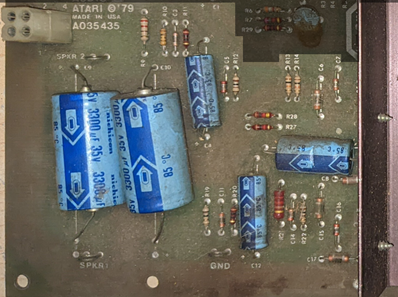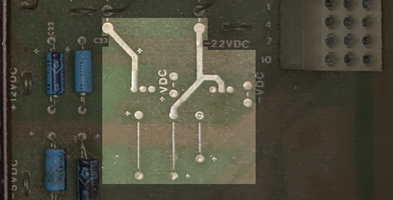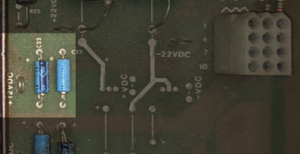Atari Regulator/Audio II (AKA the A/R-II) Version -02 Information
By James R. Twine ©2009-2023
References and Source Material
Information is this document is from personal experience with these beasts and some was stole^H^H^H^H^H… um, I mean… inspired… from many sources including official Atari docs (wiring diagrams, schematics) and Internet-based sources from authors that are far smarter than I, including:
- The Real Bob Roberts
- arcade.melchman.net
- https://bitslicer.tripod.com/ar_SENSE _mod.htm
- VAPS
- UKVAC
- rec.games.video.arcade.collecting (yes, I am THAT old)
Legalese
This document’s content was compiled and written by James R. Twine, ©2009-2023. It can be freely shared or even incorporated into other documentation if an accurate attribution is present. OK, now the common sense warning:
Some of the information in this document may be incorrect!!!
The reader (um, that means YOU) assumes all risk of using or misusing this information. I am not responsible if the information in this document results in damage to your A/R-II (R/A-II), damages your game, burns your house down, gets your sister pregnant, kills your dog, causes you to get divorced, etc. By continuing to read this document and/or apply the information contained within, you acknowledge the above and assume all risks of using the information provided.
We Will Start by Just Getting This Out of the Way…
The notorious SENSE mod. The arcade community seems split on this one. Not exactly a 50/50 split, but more people seem to recommend performing the mod. The rest vote for keeping the SENSE circuit intact, and “simply” performing proper maintenance and/or other mods on the game to alleviate the connectors heating up and burning, which is the primary reason for suggesting that one should disable the SENSE circuit.
Personally, I prefer to learn from history – suggesting that one correctly maintain their game and keep their edge connectors clean is great. But we all know that people just do not do it. So personally, I suggest performing the mod, and directions for doing so are included in this document. Besides, I think it is better to find out that your connectors are going bad by a voltage drop causing the game to stop working, not by your connectors getting too hot and deteriorating further.
That said, you will see people talk about “bulletproofing” an A/R-II, and then they simply go about describing the SENSE mod.
THIS IS NOT BULLETPROOFING!
Anyone that says that simply performing the SENSE mod is bulletproofing1 an A/R-II is lying to you or just does not know any better. Why? Because if the +5V regulation fails it is still possible to end up with more than +5V over the +5V line, which could damage any board connected to it. What kind of “bulletproofing” is that? (Shameless plug: that is why I designed a PCB with an adjustable crowbar circuit – THAT is how you bulletproof an A/R-II!) Anyway – rant over… information on an easy way to perform the SENSE mod is shown below where I document connector J7.
Meet the Atari Regulator/Audio II (mod -02)
This component, affectionately referred to as the A/R-II (“A Are Two” even though calling it the R/A-II would be more correct) was used in many of Atari’s games from the ‘70s and ‘80s. It exists in various forms, from the original Regulator/Audio board used in early B/W games like Asteroids and Atari Football, to the Regulator/Audio II used in many different color games to about the mid ‘80s (e.g. Centipede, Dig Dug, Kangaroo, Missile Command, Pole Position, Tempest, etc.), to the Regulator/Audio III.
Its primary purpose was to supply necessary voltages for the game (logic, audio, and sometimes things like the odd voltages required to erase an EAROM), as well as provide audio amplification. Different versions of the board provided different features like different voltages, more amperage, etc. The image below shows a -02 version.
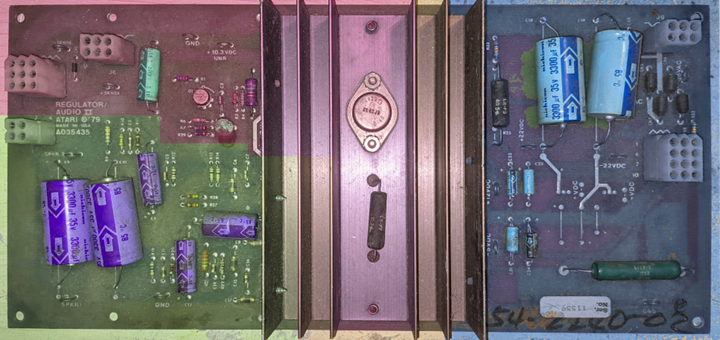
The board can be roughly divided into 3 areas that are shaded purple, green, and blue in the above image. The middle and upper-left areas are +5V regulation, the lower-left is audio amplification, and the right side is secondary voltages (-5V, +12V, and +/-22V). It is worth mentioning that both “halves” of the board are logically separate. You can apply power to only the left side and get your +5V and audio amps. And you can apply power to only the right side and get your secondary voltages. Both sides do not have to be powered up at the same time.
The connectors are consistent between other versions and revisions of the board, so it may be possible to substitute one for the other depending on the voltages and/or features required. For example, a -03 can usually be used to replace a -02.
Connectors
We will go through the connectors in order of their designations.
J6 – Main Power Input
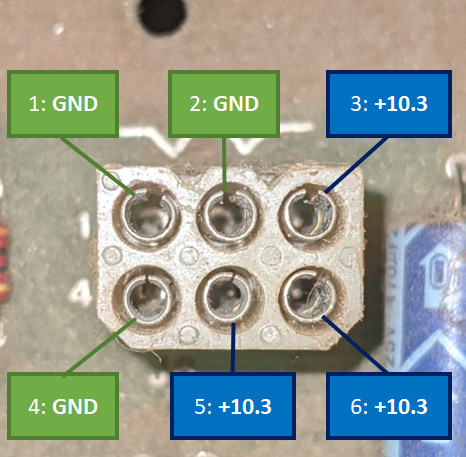
This connector supplies the power required to produce the regulated +5V and power the audio amps. Note that the +10.3VDC input is unregulated and may normally measure a couple of volts higher when not loaded, such as if you meter it directly on the power brick.
J7 – Main Power Output and Audio Input
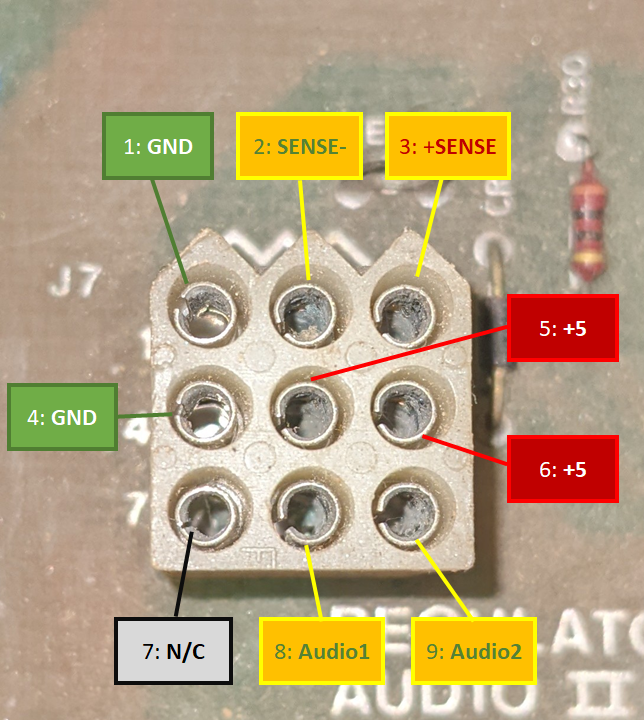
This connector supplies the regulated +5V as well as the SENSE lines. It also is where unamplified audio comes into the board.
SENSE Circuit Description and the SENSE Mod
So, how about we stop here for a second to talk about SENSE. You may have heard of the infamous SENSE circuit on these boards, but what does it really do? Well, it is supposed to detect a voltage drop between the power supply and the game’s board. On the game’s PCB the +5V is routed to +SENSE, and GND (the +5V return) is connected to -SENSE. The A/R board uses the voltage coming back on the SENSE lines to determine if it needs to bump up the voltage to compensate for any voltage drop that occurred on the way to the game’s PCB (though the wires, connectors, etc.). Sounds like a good idea at first, right?
Well, now throw in a failing +5V connection to the board – like a dirty connection or a physically failing one. As more and more voltage is lost, the SENSE circuit will keep boosting the voltage, which can lead to overheating and exacerbate the failing connection. Remember that the +5V and +SENSE are connected on the game board? Well, if the +5V connection fails badly enough, the game might try to draw current over the +SENSE line. This is the cause of the infamous smoking of R30 (and sometimes R29) – the game is trying to draw multiple amps across that poor little ¼ or ½ watt resistor.
So, the SENSE mod tricks the SENSE circuit into always seeing exactly what the A/R board is putting out. This is done by connecting +5V and +SENSE together, and GND and -SENSE together, on the A/R board itself. The easiest(?) way to do this is to turn the A/R board over and solder a jumper between pins 1 and 2, and another one between 3 and 6 on connector J7. Note that after doing this, you may have to manually adjust the +5V pot to get a solid +5V at the game board.
It is also worth noting that if you ever need to bench test the board or adjust the voltage using the pot at R8, make sure that the +SENSE line is connected back to the +5V line either via the mod or by connecting-up a game board. The +SENSE line is what is connected to the feedback input on the +5V regulator and and this feedback circuit is necessary for the board to work correctly. If you think you will be benching a lot of these boards, it may be worth created a plug that mates with J7 and wires-up the SENSE lines accordingly.
J8 – Speaker (Amplified Audio) Output
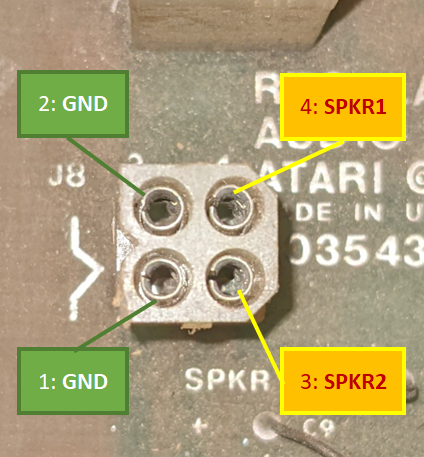
This is the amplified audio (Speaker) connection. If you are used to seeing positive and negative speaker signals, consider the SPKR1 and SPKR2 signals to be the positive ones, and the GND to be the negative ones.
J9 – Secondary Power Input

This connector provides the 36VAC (note – AC, not DC like on J6!) input voltage to the board which is necessary to generate the additional +12, +/-22, +/-15, and -5 voltages. Not all A/R boards are stuffed to produce all the secondary voltages. On the board shown in this document, the area that would be used to produce the +/-15V is unpopulated.
J10 – Secondary Voltage Output
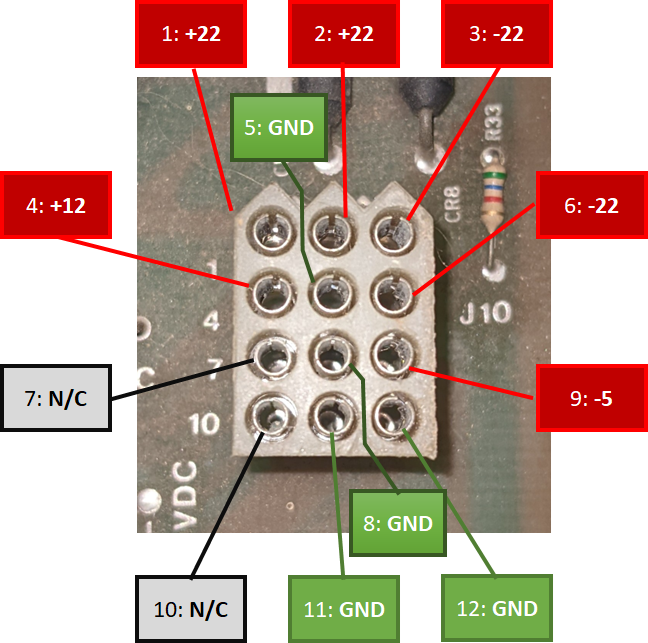
This connector provides the additional voltages produced from the 36VAC provided on connector J9. (Pins 7 and 10 would be the +/-15V if it was present on this board.) Also note that the +/-22V is unregulated and directly connected to the bridge’s filtered output, so do not be surprised if you see a higher voltage when unloaded.
Operation
Here I will try to describe how this A/R board works.
Primary +5V SupplyThe primary +5V supply derives from the Excessive voltage or no voltage on the |
Audio AmplifiersAudio amplification is provided by the two TDA2002(AV) amplifiers. If you are having problems with distorted sound, I would start with the two larger output coupling caps, C9 (SPKR1) and C10 (SPKR2) before looking at the amplifiers themselves.
|
Troubleshooting
This section covers a few things that might help with troubleshooting and repair of an A/R-II.
First is a good adjustable power supply to produce the +10.3V for the primary side and either a transformer that will output ~36VAC or a variable one for the 36VAC for the secondary side. I recommend working with one side at a time.
Next is to get a good quality 2-ohm, 20 W cermet resistor. When briefly connected between +5V and GND it will pull 2.5 amps and I believe this is a suitable load to test the +5V line with.
If testing on a bench, be sure to either have the sense mod performed or jumper together the +SENSE+5V-SENSEGND
Problem/Symptom |
Possible Cause(s) |
+5V is present and seems stable when measured while unloaded but drops to a much lower voltage when loaded. |
1. The 5V regulator may have failed.
2. The 5V regulator is working, but the board cannot provide the additional current that would normally be provided via Q2 and/or Q3, so one or both may have failed (likely just Q3). |
No +5V present, audio amplification seems to be working. |
1. This could mean that the 5V regulator has failed.
2. This could mean that the 5V regulator is working, but the board cannot provide the additional current that would normally be provided via Q2 and/or Q3, so one or both may have failed (likely just Q3). |
No +5V and no audio amplification. |
Check 10.3VDC input and fuses on power brick. |
| One or more audio channels is not working. | The amplifier for that audio channel may have failed – the TDA2002 at Q5 for SPKR1 and/or the one at Q7 for SPKR2. |
| One or more audio channels are distorted. | The output coupling cap for that audio channel may be leaky and need to be replaced – C9 for SPKR1 and/or C10 for SPKR2. |
+5V has excessive ripple present or the game is experiencing excessive crashes, resets, visual artifacts, odd behaviors, etc. Sometimes an audio hum can also be heard. |
Check the large filtering capacitor (the “Big Blue”) on the power brick. |
Secondary voltages have excessive ripple present (especially noticeable on the +/-22V). |
Check the two large filtering capacitors on the right side of the board – C18 and C19. |
| Secondary voltages are missing a polarity or a reduction in output is voltage is present | One or more of the diodes that comprise the full-wave bridge rectifier on the right side of the board may have failed – CR5, CR6, CR7 or CR8. |
| Missing one or more of the regulated secondary voltages. | The regulator for the associated voltage may have failed – the 7905 for the -5, or the 7812 for the +12. |
| Pulling too much current on the 36VAC (blown fuses). | One or more diodes in the bridge may have shorted – CR5, CR6, CR7 or CR8. |
Component Layout and Parts List
The following is a redrawn parts layout for this A/R-II board. Location may not be precise or exact down to a millimeter but should allow you to locate and identify components of interest. A parts list is also included.
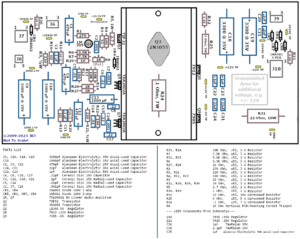
Modifications
Converting a -02 to -03
The version -03 of the AR-II is almost identical to the -02 but with a few changes for the increased current demands of Missile Command (and Monte Carlo?). The differences are:
R25 – a 4 ohm 5W resistor, is replaced with a jumper (or you might see a black zero-ohm resistor)
R31 – a 22 ohm 10W resistor is replaced with a 15 ohm resistor
This also means that you should be able to safely substitute a -03 for an -02 if necessary.
[1] You do not wear a bulletproof vest to prevent things from going wrong, you wear one for when things do go wrong. If you are not able to completely prevent or robustly handle a catastrophic failure, I would suggest that you are not bulletproofing.
Schematic
Here is a mostly searchable PDF of the schematic: AR-IISchematic(OCR)

